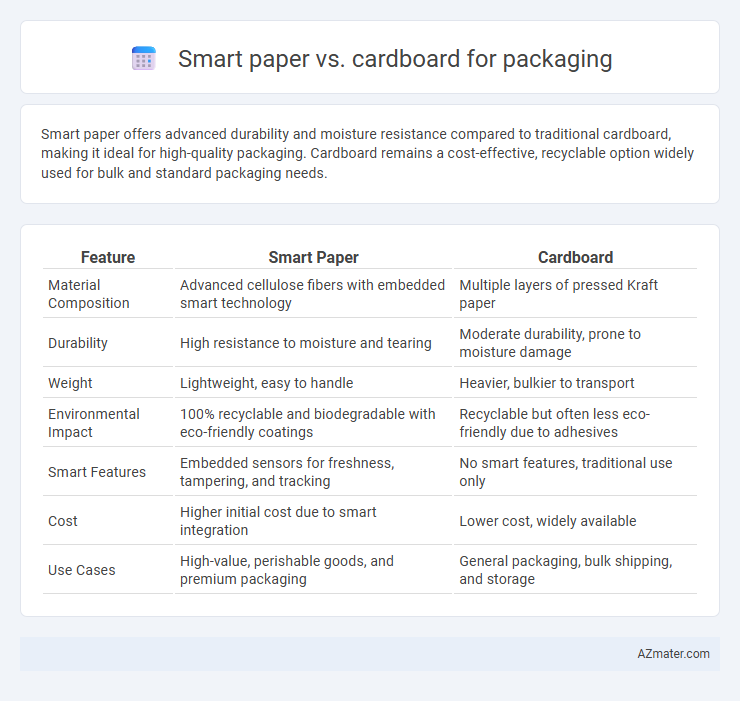Smart paper offers advanced durability and moisture resistance compared to traditional cardboard, making it ideal for high-quality packaging. Cardboard remains a cost-effective, recyclable option widely used for bulk and standard packaging needs.
Table of Comparison
| Feature | Smart Paper | Cardboard |
|---|---|---|
| Material Composition | Advanced cellulose fibers with embedded smart technology | Multiple layers of pressed Kraft paper |
| Durability | High resistance to moisture and tearing | Moderate durability, prone to moisture damage |
| Weight | Lightweight, easy to handle | Heavier, bulkier to transport |
| Environmental Impact | 100% recyclable and biodegradable with eco-friendly coatings | Recyclable but often less eco-friendly due to adhesives |
| Smart Features | Embedded sensors for freshness, tampering, and tracking | No smart features, traditional use only |
| Cost | Higher initial cost due to smart integration | Lower cost, widely available |
| Use Cases | High-value, perishable goods, and premium packaging | General packaging, bulk shipping, and storage |
Introduction to Smart Paper and Cardboard Packaging
Smart paper integrates advanced technologies such as sensors and conductive inks, enabling enhanced functionality like tracking, temperature monitoring, and anti-counterfeiting features in packaging. Cardboard packaging, made from recycled paper fibers, offers durability, eco-friendliness, and cost-effectiveness, making it ideal for protecting and transporting goods. Both materials serve distinct purposes in packaging, with smart paper providing interactive capabilities and cardboard ensuring structural support.
Material Properties: Smart Paper vs Cardboard
Smart paper offers enhanced flexibility and lightweight characteristics compared to traditional cardboard, making it ideal for delicate or compact packaging. Cardboard provides superior rigidity and shock absorption due to its thicker, multi-layered structure, ensuring robust protection for heavier or bulkier items. Both materials differ significantly in moisture resistance, with smart paper often requiring coatings for durability, while cardboard naturally withstands moderate wear and tear through its dense fiber composition.
Sustainability and Environmental Impact
Smart paper offers superior sustainability compared to traditional cardboard, as it is often made from renewable resources and designed for easy recyclability with minimal chemical treatments. Cardboard, while biodegradable and recyclable, typically requires higher energy consumption in production and may involve adhesives or coatings that hinder full environmental benefits. Choosing smart paper over cardboard significantly reduces carbon footprint and waste generation in packaging applications.
Cost Efficiency and Affordability
Smart paper offers superior cost efficiency compared to cardboard due to its lightweight material, reducing shipping expenses and storage requirements. Cardboard, while generally affordable upfront, often incurs higher long-term costs because of increased weight and less efficient recyclability. Brands seeking affordable, sustainable packaging solutions prioritize smart paper for its balance of cost-effectiveness and environmental impact.
Durability and Protection in Packaging
Smart paper offers enhanced durability for packaging through embedded fibers and coatings that resist tearing and moisture, making it suitable for lightweight yet protective applications. Cardboard provides superior protection due to its rigid, multi-layered structure, effectively absorbing shocks and preventing damage during transportation. The choice between smart paper and cardboard depends on the specific packaging needs, balancing flexibility and environmental impact against the level of physical protection required.
Design Flexibility and Customization
Smart paper offers superior design flexibility compared to cardboard due to its thinner profile and adaptability to various shapes and printing techniques. Customization options with smart paper include advanced surface treatments and embedded technologies, enabling interactive and high-resolution graphics that enhance brand engagement. In contrast, cardboard provides robust structural integrity but is limited in intricate design and fine-detail customization, making smart paper ideal for premium, visually dynamic packaging solutions.
Printing and Branding Capabilities
Smart paper offers high-resolution printing capabilities with vibrant colors and fine details, making it ideal for intricate branding designs and personalized packaging. Cardboard provides a sturdy surface for large-scale prints and bold graphics but often lacks the precision and color depth achievable with smart paper technologies. Brands seeking crisp imagery and detailed visual storytelling typically prefer smart paper, while cardboard is favored for eco-friendly, durable packaging solutions with simpler print requirements.
Smart Features: Innovations in Packaging
Smart paper integrates advanced technologies such as embedded sensors, NFC tags, and QR codes, enabling real-time tracking, authentication, and interactive consumer engagement. Unlike traditional cardboard, smart paper can monitor environmental conditions like temperature and humidity, ensuring product safety and quality during transit. These innovations enhance supply chain transparency and provide valuable data analytics for optimized inventory management.
Applications Across Different Industries
Smart paper offers enhanced durability and digital integration, making it ideal for industries like healthcare and electronics where tracking and authenticity are critical. Cardboard remains the preferred choice in retail and food sectors due to its cost-effectiveness and excellent protective qualities during shipping and storage. Both materials are increasingly important in sustainable packaging solutions, with smart paper enabling interactive features and cardboard supporting recyclability.
Choosing the Right Packaging: Factors to Consider
Choosing the right packaging between smart paper and cardboard depends on factors such as sustainability, durability, and cost-effectiveness. Smart paper offers enhanced biodegradability and printability with customizable features, ideal for eco-conscious brands seeking lightweight solutions. Cardboard provides superior structural integrity and cushioning, making it suitable for heavier items and long-distance shipping requirements.

Infographic: Smart paper vs Cardboard for Packaging
 azmater.com
azmater.com